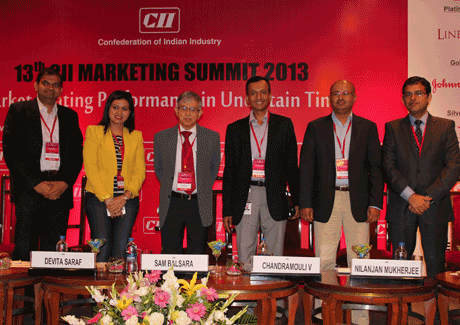The assumption that one half of advertising does not work (and marketers struggle to find out which half that is) is in perhaps unfair today, reasoned Sam Balsara, CMD, Madison World. He was moderating the first session on day two of the 13th CII Marketing Summit hosted in Mumbai on 27 and 28 November 2103.
He reasoned that from ‘50 per cent’ that was said to be ineffective, the number might be down to 15 or 20 per cent today.
Setting the tone for the panel on ‘Getting the most from your investments in marketing and sales’, he added, “However, I suspect that as long as brands get created on the basis of creativity, such questions will continue to exist.”

‘Reach, cost, quality’
Ramdoss Seetharaman, associate principal, McKinsey & Co., pointed out that 20 years ago, marketers thought of return on marketing investment (RoMI) as a combination of (i) reach (ii) cost and (iii) frequency (R-C-K). While that still remains relevant in commoditised categories and low involvement purchases, it has changed in line with the new customer decision journey, said Seetharaman.
“Two factors that affect how companies operate in different sectors (in evaluating marketing RoI) are (i) availability of data and (ii) involvement in purchases.”
In the case of high involvement purchases, he said that the shift from R-C-K was more. The customer decision journey is broken down into four stages according to the McKinsey Principal:
- Consumer ideation
- Active evaluation
- Moment of purchase and
- Post purchase experience
“And then companies figure, for their brand, where is the marketing boost required. In some cases, post evaluation, there is a change in the media mix; as certain parts of media work better in certain parts of the customer decision lifecycle,” he explained.
Adding that the model to do this, while involving continuous flow of data and analysis, was not just mathematical, he stated, “What best in class companies do, is they arrive at a theoretical conclusion. And then start the process of evolving based on real world constraints – that could be constraints on buying or their own strategic priorities.”

‘Stand behind your existing initiatives’
Cadbury India’s Asia Pacific regional chocolate category head Chandramouli Venkatesan simplified the RoMI as a mathematical equation – spends being the denominator and returns being the numerator. While that left the task rather well defined, he added, “You have to deal with both.”
“Far too often, when people think of increasing the return on spend, there is a focus on how you spend the money – which medium, how premium, and so on. Return is really impacted by what you spend on, rather than how you spend. You have to put more money behind the more responsive, profitable part of the portfolio – especially in difficult times,” explained Venkatesan.
Citing an example of focus on what works better, he noted that Cadbury Dairy Milk from the company’s portfolio was five times as responsive as Bournville.
A second point Venkatesan put forth to the audience was on the importance of persisting with existing marketing initiatives, in order to be able to reap the increasing returns with every passing year.
“As marketers we are guilty of chasing too many new things, and not spending behind initiatives we already spent on,” he said.
Cadbury Dairy Milk’s ‘Kuch Meetha Ho Jaaye’ campaign is into its 11th year, revealed Venkatesan, adding that the RoI was increasing year-on-year because the company was ‘staying put’ behind the campaign.
On optimising spends, he urged marketers to identify what part of the marketing investment was not working and reduce that. Venkatesan surmised, “Resist the temptation to take out 5 to 10 per cent off everything. Take 50 per cent off one thing that doesn’t work. That takes courage.”
Asked by moderator Balsara how he managed to convince his CEO to increase the marketing budget each year over the last five years, Venkatesan ceded that Cadbury India would have been the 15th or 20th largest advertiser five years ago – but would be the fifth largest today.
“Results are the most important thing. Rash increase in budgets without knowing that it works is foolish. Second, you need to find what the risk you can take with factors within your own control is. For example, in 2011, the annual budget was increased by 20 per cent. But in Q1, we spent 50 per cent more (than the same quarter the previous year). If the returns hadn’t come, I would have had to struggle, but they did. Sales grew 55 per cent. So we were able to show the results and ask for more budgets for Q2,” he explained.

Differentiation in positioning, marketing
Devita Saraf, CEO, Vu Technologies, a six year-old electronics player, explained that the company has taken a marketing-centric approach since its inception. The approach involved staying differentiated from the competition on the marketing approach as well as the portfolio, allowing it to offer products at price points well above some established domestic brands.
“When you operate in the price market, profit is also affected. On the marketing side, we owned the concept of luxury, taking concepts from hospitality and luxury sectors. Today, we sell 84” TVs for Rs 9 lakh,” said Saraf.
While Japanese major Sony spends Rs 350 crore in the Diwali season, she claimed that VU spent Rs 3.5 crore all of the previous year – but was still able to compete. Working with an agency set up in-house allows it speed-to-market, added Saraf.

Customisation and segmentation
Five years ago, 85 percent of the sales of the Arrow brand from the Arvind Lifestyle stable came from shirts, revealed the SVP and COO of the company’s tailored clothing and sportswear division, Rishi Vasudev. This number is down to 50 per cent with growth in sales of other items. On another front, from the mainstay of formals, smart casuals outsell formals at many of the counters today, he said.
He pointed to the retail environment and the clothes that are unveiled every season as two key parts of the marketing mix. “In a season, we launch 1,000 new SKUs. The products actually communicate what you are as a brand, and the kind of customer you are going after,” he said.
The Arrow strategy has been to identify which customer segment it was going after, and customising the marketing mix based on the segment targeted. For the existing customer profile identified as ‘George’, the focus is on the retail presence, product innovation and loyalty. For the new customer ‘Arnie’, media and ATL played a big role, explained Vasudev.

Efficiency through neuroscience
Entering the personal care category ‘100 years late’, ITC has still been able to make a dent, noted Nilanjan Mukjerjee, head of marketing. He explained how, with elements of effective campaigns in slow times.
The three things Mukherjee cited as essentials for creative effectiveness were:
- Ability of the ad to grab consumer attention
- Branded memorability and
- Clarity of message
The first pointer he presented delegates was to manage creatives effectively through shorter edits. Using Neuroscience, he claimed ITC had managed to plot the points of high engagement to create shorter edits of 10 and 15 seconds.
In the category of deo brand Engage, the approach could not have been about appointment viewing but about a high number of spots and owning of certain genres, explained the marketing head.
“Because of effective 10-second creatives, we got spontaneous awareness scores as high as 60 per cent in the top eight metros. In terms of market share, we were number one in Kolkata in five months. In many others, we were number two or three,” surmised Mukherjee.


